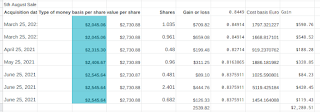It’s December again and time to pay up the Irish Capital Gains taxes (if you are an Irish tax resident) for the first period of 2021. If you need more info about it, look at citizensiformation.ie. I have just calculated my due capital gains this weekend and I thought to share some of my tips.
I’m not a tax professional, so as always feel free to double check any advice on this blog.
Gain != Gain in foreign currency converted to EUR at current exchange rate
One big pitfall you can make while computing your gains for assets in USD is to look at the gain in USD and convert it to EUR at the current exchange rate.
Why is that bad? If the exchange rate was constant, then it wouldn’t be a problem at all. But if the rate fluctuates, the difference can be substantial.
Imagine you invested 100 EURO in December 2016. With exchange rate 0.95, this gets you ~105 USD, you buy stock X with it. Then in January 2018 you sell your stock for 115 USD, it appreciated, nice! The gain in USD is 10. But you haven’t noticed that the USD to EUR exchange rate has shifted, in January 2018 it was 0.82 and 115 USD is only 94.3 EUR. Yikes. Your gain in euro is actually a loss of 5.7 EUR, your gain in USD is 10 USD, 10 USD converted to euro it would be 8.2 EUR. If you multiply it by 100, the difference between 820 gain vs 570 loss is quite substantial.
You can think that you had a gain, when you actually lost money if USD loses value compared to EUR, but it can go the other way as well. It can get stronger and you might end up needing to pay higher gains that you would anticipate just based on the USD gain converted to EUR at the current rate.
I present you some exchange rate graphs for USD to EUR and GBP to EUR over last five years. The rates change over time pretty significantly.
What is the real gain?
The gain instead should be computed as:
Sold asset value (converted to euro at the rate at the time of selling) - Cost basis (converted to euro at the time of buying)
How to make computing your gain less of a pain
In 2021 I sold stocks 10 times, the most I ever did in a year. Part of it was simplifying my portfolio by selling off some of my individual stock holdings and the other part was selling the company stocks I got from my employer as part of my compensation.
And I bought the stocks I was selling over many transactions.
Luckily a big part of those transactions happened in degiro, where you can export your transactions and get values in euro (if your account is in euro) and that makes the calculations a ton easier. I was able to put it into Google Sheets, and it was quite straightforward.
But some of my other transactions, the ones outside of degiro, were all in USD. And there was probably 17 different dates involved. Ooooh. Googling the exchange rate for those dates and pasting to the spreadsheet would be too much pain for me.
The good thing is that even though I am not a spreadsheet wizard, I knew about the GOOGLEFINANCE function that can give you not only stock prices, but also currency exchange rates for particular dates.
If you enter the following formula:
=GOOGLEFINANCE(“USDEUR”, “close”,”2021-04-26”)
you will get the USD to EUR exchange rate at 26 of April 2021. You will have to multiply your USD value by it to get the value in EUR.
=INDEX(GOOGLEFINANCE(“USDEUR”, “close”, A51),2,2)
Here are some resources if you want to learn more about it:
- https://support.google.com/docs/answer/3093281?hl=en
- https://www.howtogeek.com/449986/how-to-convert-currency-in-google-sheets/
Once you get your formula, it’s easy to reuse and extend it.
It was still a bit of a pain, but much less than it would be manually. I store capital gains calculations for each year in a separate sheet of the same spreadsheet for future reference.
Since I work in software, I couldn’t help, but I started working on a better software solution to track both gains and dividends as well as help analyze the portfolio. I hope this will be the last time I do those calculations in a spreadsheet like this. If you are interested, you can find the site at https://invertimo.com/, it’s free. If you have any feedback, feel free to write to me at justyna@nerdie-investing.com. I am also planning to extend it to make computations typical to crypto easier, as I put some small amount of money in crypto this year and it keeps giving me staking rewards and interest daily.
According to koinly (Crypto tax software I’m trying out), I’ve already had more than 900 transactions this year (from staking and savings interest). It will make my taxes more interesting in future years.


